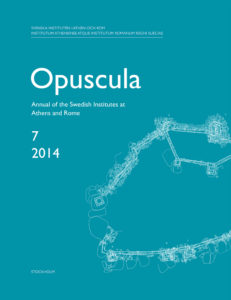 Opuscula is published by the Swedish Institutes at Athens and Rome, with the aid of a grant from the Swedish Research Council. Distributed by Eddy.se AB. View journal at ERIH PLUS. All content available with open access.
Opuscula is published by the Swedish Institutes at Athens and Rome, with the aid of a grant from the Swedish Research Council. Distributed by Eddy.se AB. View journal at ERIH PLUS. All content available with open access.
Ancestors at the gate. Form, function and symbolism of the imagines maiorum. A comparative analysis of Etruscan and Roman funerary art
Abstract
Scholars have interpreted the imagines maiorum (face-like representations of Roman familial ancestors), such as the ones represented in the famous Barberini statue, as wax masks that were worn by actors who impersonated the dead during funeral processions. Since members of the Roman aristocracy displayed the imagines of their ancestors who had held an important office, most scholars have concluded that the usage of the imagines was merely social and political and therefore devoid of any ritual or symbolic value. My paper, through close analysis of Roman literary and material evidence, argues that the imagines maiorum were not masks but complete portable wax heads; furthermore, that the imagines displayed in the Roman atrium, in addition to serving as status markers, played an important role in domestic rituals. There is convincing evidence that the imagines were objects of specific, periodic ritual acts (burning of incense, application of colours and laurel). Finally, I argue that the imagines maiorum, paraded at the head of a funeral procession, had a significance beyond aristocratic pomp: from the ritual opening of shrines to the arrival at the tomb, the imagines maiorum represented the ancestors who, together with the living, accompanied the deceased in his journey to the afterlife—a scene depicted in several Etruscan tombs.
Download PDF - Size: 620.96 KB - Downloads: 887 (since 2023)
Bibliographical information
Chiara M. Mazzeri, ‘Ancestors at the gate. Form, function and symbolism of the imagines moiorum. A comparative analysis of Etruscan and Roman funerary art’, Opuscula. Annual of the Swedish Institutes at Athens and Rome (OpAthRom) 7, Stockholm 2014, 7–22. ISSN: 2000-0898. ISBN: 978-91-977798-6-9. Softcover, 257 pages. https://doi.org/10.30549/opathrom-07-02

No Comments
Comments are closed.